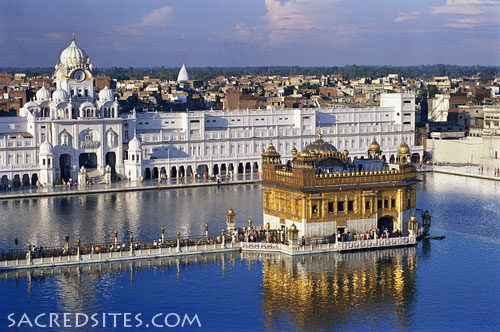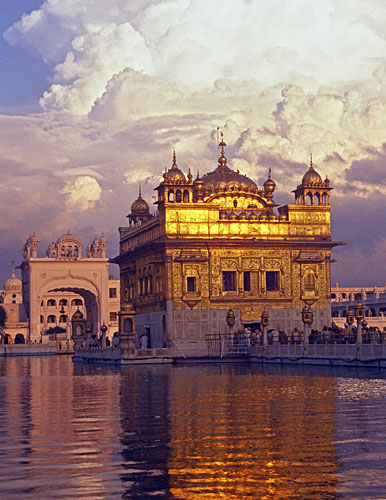The Golden Temple, Amritsar

The Golden Temple (Enlarge)
The Golden Temple, located in the city of Amritsar in the state of Punjab,is a place of great beauty and sublime peacefulness. Originally a small lake in the midst of a quiet forest, the site has been a meditation retreat for wandering mendicants and sages since deep antiquity. The Buddha is known to have spent time at this place in contemplation. Two thousand years after Buddha's time, another philosopher-saint came to live and meditate by the peaceful lake. This was Guru Nanak (1469-1539), the founder of the Sikh religion. After the passing away of Guru Nanak, his disciples continued to frequent the site; over the centuries it became the primary sacred shrine of the Sikhs. The lake was enlarged and structurally contained during the leadership of the fourth Sikh Guru (Ram Dass, 1574-1581), and during the leadership of the fifth Guru (Arjan, 1581-1606), the Hari Mandir, or Temple of God was built. From the early 1600s to the mid 1700s the sixth through tenth Sikh Gurus were constantly involved in defending both their religion and their temple against Muslim armies. On numerous occasions the temple was destroyed by the Muslims, and each time was rebuilt more beautifully by the Sikhs. From 1767 onwards, the Sikhs became strong enough militarily to repulse invaders. Peace returned to the Hari Mandir.

Hari Mandir, Amritsar, India
The temple's architecture draws on both Hindu and Muslim artistic styles yet represents a unique coevolution of the two. During the reign of Maharaja Ranjit Singh (1780-1839), Hari Mandir was richly ornamented with marble sculptures, golden gilding, and large quantities of precious stones. Within the sanctuary, on a jewel-studded platform, lies the Guru Granth Sahib, the sacred scripture of the Sikhs. This scripture is a collection of devotional poems, prayers, and hymns composed by the ten Sikh gurus and various Muslim and Hindu saints. Beginning early in the morning and lasting until long past sunset, these hymns are chanted to the exquisite accompaniment of flutes, drums, and stringed instruments. Echoing across the serene lake, this enchantingly beautiful music induces a delicate yet powerful state of trance in the pilgrims strolling leisurely around the marble concourse encircling the pool and temple. An underground spring feeds the sacred lake, and throughout the day and night pilgrims immerse themselves in the water, a symbolic cleansing of the soul rather than an actual bathing of the body. Next to the temple complex are enormous pilgrims' dormitories and dining halls where all persons, irrespective of race, religion, or gender, are lodged and fed for free.
Amritsar, the original name of first the ancient lake, then the temple complex, and still later the surrounding city, means "pool of ambrosial nectar." Looking deeply into the origins of this word amrit, we find that it indicates a drink of the gods, a rare and magical substance that catalyzes euphoric states of consciousness and spiritual enlightenment. With this word we have a very clear example of the spirit, power, or energetic character of a particular place becoming encoded as an ancient geographical place name. The myth is not just a fairy tale. It reveals itself as a coded metaphor if we have the knowledge to read the code: The waters of Amritsar flowing into the lake of the Hari Mandir were long ago - and remain today - a bringer of peacefulness.

Sikh pilgrims at the Golden Temple, Amritsar, India

Golden Temple Aerial View by Helicopter
Photograph by Grenade Singh
No comments:
Post a Comment